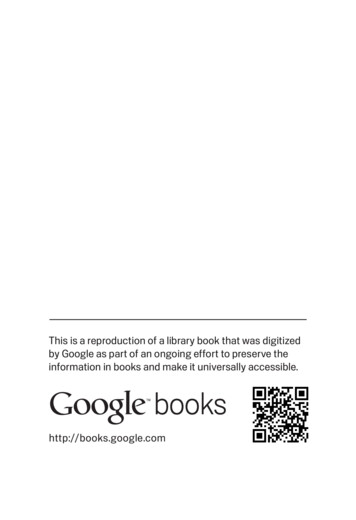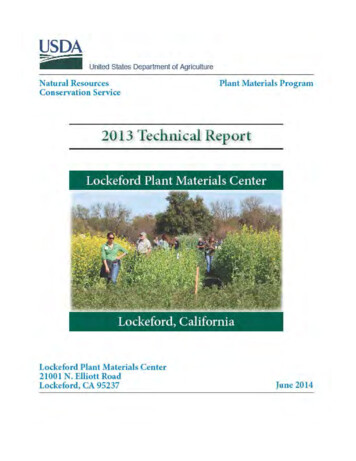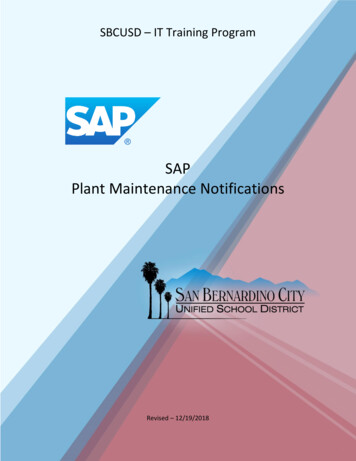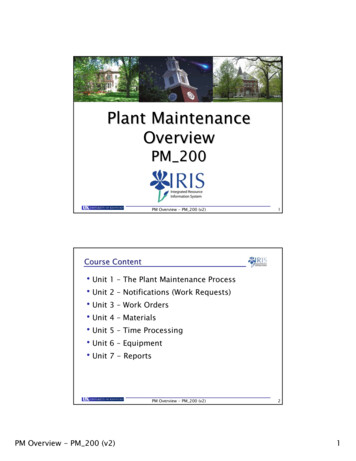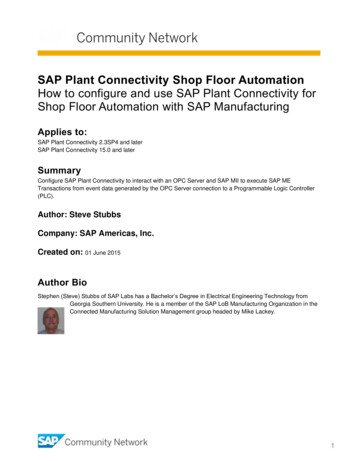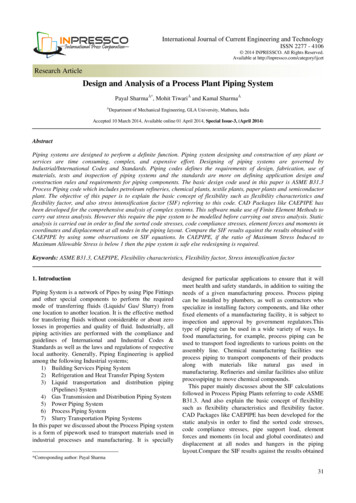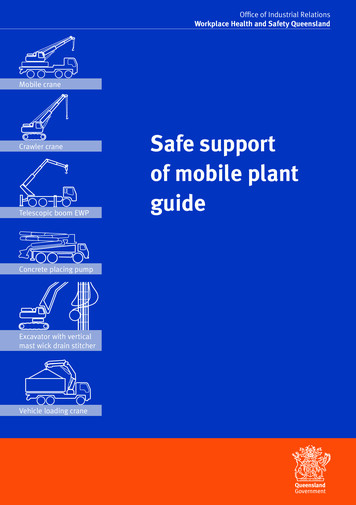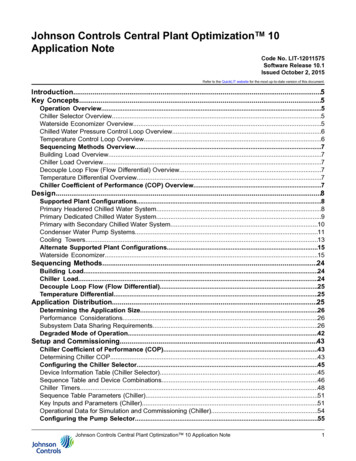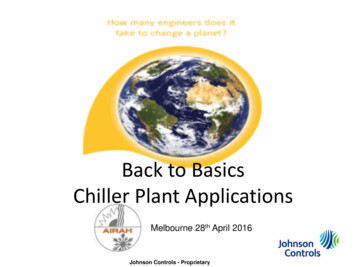
Transcription
PLANT REPRODUCTIONStudents’ worksheetsJanet HuguetJanuary – March 2009
PLANT REPRODUCTIONHOW TO CLASSIFYLesson 1NameIntroduction How to classifyEveryday, you classify. Think about it.Sorting objects and putting them in a specific place is classification.Practise classifying objects according to physical structure and characteristics.Activity 1 - Living and non-living thingsIn this activity we are going to compare and classify a set of pictures. How can they be grouped? How can they be studied? What keys are used to organize these objects into the following groups? . . . . . . . . . . . . . . . . . .Activity 2 - Sorting game. Choose a creature and try to work out which one has your classmate CrabAsk Questions like these:IsDoesCanHUGUET FITÉ, JanetithaveA mammal?Fly?Legs?Wings?Fur?A vertebrate?Warm blooded?Backbone?CEIP Antoni Roig
PLANT REPRODUCTIONHOW TO CLASSIFY3 - How can you classify these animals?(fig 1)NameCLASSIFY ANIMALS: dog, horse, bird, snake, crocodile, sardine, butterfly, whale, golden eagle,alligator, donkey, penguin, -bloodedType of bodycoveringLive birthorHatched from eggFeed young withmilk (yes/no)Has a skeletonBreathes with lungsor gillsHUGUET FITÉ, JanetCEIP Antoni RoigMAMMALS
PLANT REPRODUCTIONHOW TO CLASSIFYANIMAL KINGDOM CLASSIFICATION(fig 1)Living thingsAnimal KingdomInvertebratesVertebratesPlant KingdomAbsence of vascular tissuePresence of vasculartissue.Live in waterBreathe with gillshave skeletonWalk & swimBreathe with gills & lungsLay eggs in waterBody covered in scalesBreathe with lungscold bloodedHave wingsBody covered in feathersBeakBody covered in hair or furconstant bodytemperatureHUGUET FITÉ, JanetCEIP Antoni Roig
PLANT REPRODUCTIONHOW TO CLASSIFYActivity 4NameThe Key to living things.In pairs, classify these living things using the dichotomous key on the next sheet.Now make your own drawings and share them with other students to put into the key.HUGUET FITÉ, JanetCEIP Antoni Roig
PLANT REPRODUCTIONHOW TO CLASSIFYDICHOTOMOUS KEYHUGUET FITÉ, JanetNameCEIP Antoni Roig
PLANT REPRODUCTIONHOW TO CLASSIFYLesson 2NameActivity 1 - Living things – what they need and what they can do.(fig. 2)ApplicationChoose a plant, then write its name on the dotted line in the box in the table.Choose an animal and write its name on the dotted line in the middle of the box.Choose an object that has never been alive and write its name on the dotted line inthe last box.SynthesisLook at your plant and answer each of the questions. If the plant has thecharacteristics in the list, write YES in the box.If the plant does not have the characteristics, write NO in the box. Then repeat thisfor the animal and for the object you chose.In groups of threes compare your answers, you can use sentences likethis:I think it is a . because it .Activity 2ApplicationNow you are going to look at some pictures of animals and plants (fig 2) e.g. bee,spider, worm, mealworm, snail, dog, horse, bird, snake, crocodile, butterfly, whale,grass, ivy, holly, cherry tree, daffodil, oak tree, human which word describes theseliving things?AnalysisGroup the living things into similar groups and give the reasons for doing so.SynthesisProduce a skeleton Mind map of these groups of living things groups on a poster.EvaluationPresent your poster to rest of class.HUGUET FITÉ, JanetCEIP Antoni Roig
PLANT REPRODUCTIONHOW TO CLASSIFY- Living things – what they need and what they can do. (fig 2)CharacteristicsA plantAn animalAn object that has neverbeen alive. . .(Living things need to do allthese things)MDoesmovement?itshowanyR Does it need air oroxygen?S Does it react to what ishappening in its surroundings?G Can it grow larger?R Can it make more livingthings like itself?E Can it get rid of wastefrom itself?N Does it need food forenergy?HUGUET FITÉ, JanetCEIP Antoni Roig
PLANT REPRODUCTIONHOW TO CLASSIFYLesson 2 (fig. 3)NameActivity 3Complete the following chart.The plant KingdomNon Seed PlantsSeed PlantsSpores to reproduce"naked seed""seed vessel"Common forest trees.With needle-shapeHUGUET FITÉ, JanetCEIP Antoni Roig
PLANT REPRODUCTIONHOW TO CLASSIFYLesson 2Name:Activity 3Botanists have developed a scientific classification system to groupsimilar plants together. They make note of details about plant anatomy(especially that of flowers, fruit, seeds and leaves). They use thesecharacteristics to divide plants into categories.ApplicationWorking in pairs, read at the text carefully. After that complete theplant kingdom classification (fig 3).At the end you can test your answers looking at slide 11 on the powerpoint.Plants are the key to life on Earth. Without them many other livingorganisms would soon disappear. This is because higher life formsdepend on plants, either directly or indirectly, for their food. Mostplants, however, are able to make their own food using sunlight. Allplants fall into two basic categories. Flowering plants produce trueflowers. The non-flowering plants include “primitive” plants, such ndthe“gymnosperms” a group of plants which includes the conifers.There are about 3000,000 species of flowering plant in the world today,and they grow everywhere from snowy mountains to arid deserts.HUGUET FITÉ, JanetCEIP Antoni Roig
PLANT REPRODUCTIONHOW TO CLASSIFYPLANT KINGDOMNon-Seed PlantsAlgaeMossesSeed PlantsFernsseed”“Seed als in multiples of 3Dicot-Petals in multiples of 5HUGUET FITÉ, JanetCEIP Antoni Roig
PLANT REPRODUCTIONHOW TO CLASSIFYActivity 4 – Sort it – game with cards.This activity is based on the card game “Happy families”. There are 24 cards in thepack, made up of six sets of four cards.1. Play the game in groups of three or four players. Spread the cards out (faceupwards) and then sort them into groups in whatever way you like.Then give children several minutes to discuss this. After that the children reportback to rest of the class saying how they have sorted their cards and theirjustification for doing so.2. Can you now sort the cards into six sets of four cards?. Again discuss in yourgroups how you can group the cards.HUGUET FITÉ, JanetCEIP Antoni Roig
PLANT REPRODUCTIONHOW TO CLASSIFYName:Revision activity1. Use the information from the boxes to complete the questionsScientists put living things into groups to make studying them easier.The two main groups are animals and plants.We can use keys to help us to identify living things.a) Why do scientists put living things into groups?b) What is the main difference between animals and plants?2. Write true or false next to each statement.1. Living things are easier to study if they are classified.2. Classification is the process of grouping things.3. Geologists are scientists that classify living things.4. Latin is the language often used by scientists to name livingthings.5. Living things can be grouped into five major kingdoms.3. Discovery Carolus Linnaues.In a pair work students can look for Carl Linnaeus Biography reading the articlefrom the Internet.HUGUET FITÉ, JanetCEIP Antoni Roig
PLANT REPRODUCTIONPARTS OF A FLOWERDISCOVERYCAROLUS LINNAEUSEarly naturalists tried to devise a system for naming species in away that everyone could understand, without consideration of theirlanguage.The scheme that biologists use today was devised in theeighteenth century by the Swedish botanist Carolus Linnaeus (1707– 1778). He used Latin names, and gave all animals and plants a two-part name,such as Sturnus vulgaris for the common starling.He used the two-part name for the same reason that people have surnames andthe first names: The surname shows what family they belong to and the firstname belongs to the individual. Scientific names for animals and plants work in thesame way as the names of people, but the order is reversed, with the “surname”coming first. This surname covers a group of related species, known as “genus”(the plural of genera).Sturnus is the genus to which all starlings belong, and vulgaris completes thename of one particular specie in the genus – the common starling.Janet HuguetCEIP Antoni Roig
PLANT REPRODUCTIONPARTS OF A FLOWERLesson 3Name:Activity 1“Everything we think we Know about ” list.- Do all plants reproduce in the same way?- Can a flower really be the secret of world domination?- Has a plant got reproductive organs?-How do plants reproduce?* Watch the power point “Parts of a flower and their functions”(slides 2 to 10).Activity 2In your pairs or threes, read carefully the functions and suit themwith the names of the parts of a plant. Using the following patterns.I think it is the .I think this is the OvuleMale reproductive organ that contains pollengrains.CalyxConsists of all the petals, which serve to attract pollinatorsthrough colour and ollinationJanet HuguetReceives the pollen from the anther.Consists of all the sepals, which protects the flower before itopensFemale reproductive organ of flowers.Where the ovules are.A stalk that supports the anther.Pollen moves from a flower to another flower, fromthe anther of one flower to the stigma of another.Where the pollen is produced.Bottle-shaped organ that contains ovules.CEIP Antoni Roig
PLANT REPRODUCTIONPARTS OF A FLOWERLesson 4Name:Activity 1Get started:Why do many flowers have brightly coloured petals?A. True or false?Tick the correct answer.TrueFalsea. Flowers have brightly coloured petals sothat humans will pick them.b. The sepals were closed to make a casearound the flower when it has a bud,c. Trees never have flowers.B. Anne has taken a tulip flower to pieces and stuck the differentparts on a piece of card.Janet HuguetCEIP Antoni Roig
PLANT REPRODUCTIONPARTS OF A FLOWERa. Help Anne to label each part of the flower with its proper name.b. The flower has male and female parts. Put a letter M besidesthe Male parts and a letter F besides the Female part.c. Match the parts of the flower to the function (what it is thatthey do for the flower) by writing the number in the linesbefore each sentence.1. stamen2. Ovary3. Anther4. Stigmaa. holds the pollenb. where the pollen enters the female part of theflower.c. the stick that holds the anthers in the air.d. where the ovules are stored.Activity 2Say this Rhyme:Roses are red,Violets are blue,Everything isJust like YOU.Activity 3TOP TIP Make a set of cards with the name of the plant part on oneside and write the function on the other side. Use them to testyourself and you’ll soon be an expert.Janet HuguetCEIP Antoni Roig
PLANT REPRODUCTIONPARTS OF A FLOWERLesson 5Names:Activity 1: A simple flower dissectionDataFigure 1: Drawing of the flower given.Color Position Label Sepals and PetalsFigure 2: Flower Pinned Open.Label: Sepals, Anther, Stamen, Filament, Stigma, Style, Ovary, & PistilTable 1: Table of Anther, Filament and Pistil Lengths in mm.Flower igure 3: Double Stem and Leaf of Pistil and Average Stamen (anther filament) Length.Table 2: Summary Data Table of Pistil and Stamen Lengths.nMaxMinRangesumMeanmedPistilStamenJanet HuguetCEIP Antoni Roig
PLANT REPRODUCTIONPARTS OF A FLOWERNames:Analysis:1. Name the female parts of your flower.2. Name the male parts of your flower.3. In your flower, which was longer?4. According to our class data table, which had the longer lengths?5. Was your flower a complete or an incomplete flower?6. Was your flower releasing pollen? How could you tell?7. Why would having a longer pistil or stamen be an advantage inpollination?8. Draw the leaf of the gladiolus, the lily or the tulip. Note themargin and vein pattern, the spotted markings.Conclusion:Write 2-3 sentences on what you learned.A3 card sheet1. Drawing of the flower givenLabel: Sepals and Petals (fig 1)2. Flower Pinned Open. (fig 2)Label: Sepals, Anther, Stamen,Filament, Stigma, Style, Ovary,& Pistil3. Pistil (fig 3)4. Stamen (fig 3)Conclusion:a.b.c.Janet HuguetCEIP Antoni Roig
PLANT REPRODUCTIONPARTS OF A FLOWERExtensionName :Using the data from each lab group in your class, create a line graphof length in mm (y- axis) vs. flower position (x-axis). Using 3 lines,graph the average lengths of the anthers, pistils, and stamens. Doyou notice any trends?y(length mm)X(flower position)1. Write a suitable question for each answer:a.?It consists of stigma, style and ovary.b.?The pollen lands on the tip of the female organ in the flower and thenstarts to grow inside until it reaches the egg equivalent.c.?Algae, mosses and ferns are the main plant group that don’t haveflowers and therefore can’t make seeds. Instead they produce spores.d.?Pollination happens first.e.?The petals die and fall off.Janet HuguetCEIP Antoni Roig
PLANT REPRODUCTIONPARTS OF A FLOWERName :2. Complete the sentences, by joining a beginning with an ending using the keygiven and after that, label the parts of the flower.Beginnings123456The female sex cell in plants iscalledThe female sex organ in plantsis calledThe female sex organ is madeup fromThe male sex cell in plants iscalledThe male sex organ in plants iscalledThe male sex organ is made upfromEndingsthe filament and the anther.the stigma, style and ovary.the carpel.the stamen.the pollen.the ovule.3. a. What is the main difference in appearance between sepals and petals?b. What is the function of the sepals?c. What is the function of the petals?Janet HuguetCEIP Antoni Roig
PLANT REPRODUCTIONPOLLINATION & FERTILISATIONName :4. Complete the following cards and review the new knowledge with your partner.Namethepartsof theplantshownhereWhat do plants anthers do?Why doflowers havepetals?What is the difference betweenPollination and fertilisation?Janet HuguetCEIP Antoni Roig
PLANT REPRODUCTIONPOLLINATION & FERTILISATIONLesson 6Name:Activity 1 - The pollination song (to the tune of: “This land is your How do plants pollinate? Listen to this song and decide, in your groups, the order ofthe lines in your verse, write numbers from 1 to 7. Then with the whole group findthe correct order of each verse.Carry pollen they need.Or the wind that’s blowing.What gets the pollen goingDifferent kinds of birds do,Butterflies and bees,That’s what makes pollination work.To keep new plants growing?And pistils, make the flower whole.The sticky pollen.What does a plant needReproductive powers,Three things give flowersTo make a new seed?The slender stamen,Have a sweet perfumeThat birds and insects activeAnd they’ll spread the pollen as they go.Then chances are goodWhen brightly coloured flowersFind the plants attractiveAnd a sugary nectarThis plant spreads pollen on the wind.Or brightly colored,With stamens longerand the flowers are smallerIf a flower’s not scented,The signs are strongerin clusters tighterJanet HuguetCEIP Antoni Roig
PLANT REPRODUCTIONPOLLINATION & FERTILISATIONLesson 6Name:Activity 2 - Plant life cycle.Put a number in each box to show the life cycle of the plant in the correct order.a. germinationpoppy seedpoppy plant growsseed producedfertilisationb. fertilisationgerminationpollinationseed produceddaisy seedplant growsfertilisationpollinationc. plant growsseed producedgerminationpollinationdandelion seedActivity 3Circle the correct words to complete each sentence.a. Some plants are pollinated by insects/cats/slugs and other plants arepollinated by the Sun/wind/snow.b. Plants that are pollinated by the wind have rubbery/feathery “flowers”,like grasses. This is so the wind can blow through and collect thepollen/nectar.c. Most seeds need dry/moist conditions to germinate.d. Plants that are germinated/pollinated by insects are often dull/brightlycolours, and are scented. This attracts insects.e. Some seeds, such as cleavers are spread by beetles/animals when theirtiny hooks catch on fur.f. Some seeds, such as raspberry seeds, are found inside juicy flesh. This isso that flies/birds/snails will eat them and spread the seeds.Janet HuguetCEIP Antoni Roig
PLANT REPRODUCTIONPOLLINATION & FERTILISATIONLesson 7Name:Activity 1 - PollinationWrite numbers, from 1 to 5, in each label according to the correct image in the“Pollination” power point. Use the key words to help you matching the labels to thecorrect slide.Most insect-pollinated flowers are large and brightly colouredso that insects can easily find them.If they are small they may be grouped together to look like a largeflower.Pollination is the carrying of pollen from the stamens (malepart of the flower) to the stigma (on the female part of the flower).As an insect moves from flower to flower, pollen stuck to itsbody has a good chance of landing on a stigma.Wind-pollinated plants produce a lot of pollen and thisincreases the chance of success.Fertilisation takes place when the pollen tube and the ovulecome together. After fertilisation the ovule develops into a seed.Activity 2How is pollinated by? . Is pollinated by .Below are the names of six plants. Three are pollinated by insects, and three arepollinated by the wind. Decide which are which and fill in the table below appropriately.Write the name of each plant in the correct column.DandelionButtercupSunflowerStinging nettleWillow treeGrassJanet HuguetInsect-pollinatedWind-pollinatedCEIP Antoni Roig
PLANT REPRODUCTIONPOLLINATION & FERTILISATIONLesson 7Name:Activity 3Write the correct words from the box into the spaces provided to complete thesentences.Fertilisationanimal explosion waterpollination germination winddispersal1. When the pollen and ovule join together, it is called .2. Seeds have to get from the plant to the ground to allow new plants to grow. Thisis done by .3. There are four methods of seed dispersal, they are ,, , .4. is when a new plant starts to grow from a seed.Activity 4 - Dandelion Life-cycle mobile.Make a mobile of the life-cycle of the dandelion. Cut along the lines. Glue eachpicture on to card with the matching sentence on the back. Cut out. Use cottonthread to join up the mobile in the correct order.Material needed: scissors, glue, card, cotton thread, colouring pencils.The flowers die andfall off.The dandelion seedhead or “clock” forms.The seeds aredispersed by the windA bee pollinates theflower.The young plantbegins to grow.Janet HuguetThe flowers grow.The seed germinates.The seed lands insoil.CEIP Antoni Roig
PLANT REPRODUCTIONPOLLINATION & FERTILISATIONLesson 8Name:Activity 1 - Plants and their adaptations for pollination.Each student needs three wild plants (these can be from the local area).1. Identify your plants.2. Decide if any of them have adaptations for pollination as listed below.3. Write its name and draw it in the row provided alongside that feature.AdaptationName of the plant 1Name of the plant 2Name of the plant 3Highly coloured.Highly scented.Bell-shaped.Large lower lip.Bypollenbeingblown around in thewind.Flowers at night.How are the plants shown below pollinated?DandelionFoxgloveCocksfoot GrassBird’s-foot-trefolBluebellShare the results with the whole group and discuss.Which adaptation is most commonly found and why should this be so?Janet HuguetCEIP Antoni Roig
PLANT REPRODUCTIONPOLLINATION & FERTILISATIONLesson 8Name:Activity 2Write birds, fur, wind, water or explosion in the boxes to show how youthink each seed is dispersed.a. dandelionb. strawberryc. sycamored. coconutWatere. mistletoef. Himalayan Balsamg. cleaversh. elderberriesI think . seeds can be dispersed by .I think that . can be spread by .Write a sentence for each kinds of seed dispersal:a. .b. .c. .d. .e. .Janet HuguetCEIP Antoni Roig
PLANT REPRODUCTIONPOLLINATION & FERTILISATIONLesson 8Name:Activity 3Look at the seeds below and write down your hypothesis about thereasons why seeds that take a long time to fall can be blown a long wayfrom their parent plant.peaburdocksycamorea. Which seed falls the fastest?b. Which seed took the longest to fall?This bar chart shows you the time each seed took to fall.302520seconds 1510PeaBurdockSycam ore50c. Give two reasons why it helps seeds to be a long way from theparent plant:1.2.Janet HuguetCEIP Antoni Roig
PLANT REPRODUCTIONPOLLINATION & FERTILISATIONLesson 8Name:Activity 4Finding out about how fruits and seeds are dispersed.Look at these fruits carefully and answer the following questions.Half part of the class is going to investigate the blackberry fruit (a) and the otherhalf the Dandelion seed (b). Join in pairs share and compare your ideas.Do the fruit or seed have hooks?Do the fruit or seed have a parachute ofhairs?Do the fruit or seed have wings?What colour is the fruit?Is the fruit shiny?a) Blackberryb) DandelionIs the fruit or seed juicy?How do you think the seeds of your plant are spread around?Janet HuguetCEIP Antoni Roig
PLANT REPRODUCTIONPOLLINATION & FERTILISATIONLesson 8Name:Activity 5Adaptations of plants for seed dispersal.Most plants just scatter their seeds, but some have special adaptations for dispersal.1. Look at the plants below to see if they have special adaptations.2. If they have, draw or write their names in the correct box below.Blown by windEaten by birdsBuried orcarried bymammalsBursting andscatteredCarried bywaterHow are the fruits shown below adapted for seed dispersal?Sweet chestnutAlder conesBlackberriesCleaversPine coneCompare your answers with a classmate and then think about the followingquestion. Which adaptation for seed dispersal is most commonly found?Janet HuguetCEIP Antoni Roig
PLANT REPRODUCTIONPOLLINATION & FERTILISATIONLesson 8Name:Extension activity.INSECT POLLINATIONPollination is when a grain is carried from one plantto another.The pollen is made in the , which is the male part ofthe plant. are attached to the flowers because oftheir bright and strong smell. The bee lands on theflower and pick up the pollen from the . The bee thenflies to another plant and leaves the pollen on the ofthe plant. The stigma is the part of the flower. Thepollen grain then goes down the style to fertilise anin the . They can then grow into aAnd the ovary can turn into the .The Missing Words!!!Janet insectsovaryCEIP Antoni Roig
PLANT REPRODUCTIONASEXUAL REPRODUCTIONLesson 9NameActivity 1Watch the Asexual Reproduction Video and complete the text choosing the correctword in M0sw VjBJoUOQAfter winter has thawed, the first flowers of early (spring / summer)appear. But these plants have not grown from seeds, they have reproduced from(rhizomes /bulbs).Bulbs enable plants to reproduce asexually. That is (with/without)producing gametes. Bulbs are known as perenating organs. They allow plants to survivein (favourable/adverse) conditions and then to grow quickly whenthe time is right.The swollen rhizomes of irises have a similar function, but asexualreproduction does not rely solely onperenating organs.This Liverwort can reproduce asexually via gemmae. Gemmae are smalldiscs of green tissue that grow inside special caps. When mature, theybreak off from the parent plant often due to the action of rain drops.They scatter away from the parent plant and will eventually grow into anew gammetophyte plants.Plants like this bryophyllum can also reproduce asexually. Miniature plantlets developat the edges of its leaves, in time these will drop off and develop into independentplants.Mature strawberry plants are able to establish new plantlets on the end of long(rhizomes / runners).Gardeners are able to cultivate plants asexually via (cuttings/corns).This is possible because of stems cells like these are able to trigger the formationof root cells and will start to grow roots.The ability of many plants to reproduce asexually helps commercial growers, becauseit’s quicker and more reliable than growing plants from seeds. It also ensures growersthat quality is consistent.Asexual reproduction is all about exploiting a good niche. In such circumstances thevalue of sexual reproduction, with its results and diversity may actually weaken thedominance of an established group. But, in a changing environment(uniformity / diversity) means survival.Huguet Fité, JanetCEIP Antoni Roig
PLANT REPRODUCTIONASEXUAL REPRODUCTIONLesson 9NameActivity 2Asexual Reproduction – Growing geraniums (pelargoniums) from cuttings.A cutting is any vegetative part of the plant, stem, leaf, or root used to produce anew individual.Resources for each child: A small plastic pot (7 cm diameter)There must be some holes in the bottom of the pots to drainfreely. Two plastic dishes.A polythene bag, large enough to enclose the pot (transparent) or half of a 1.5litre lemonade bottle.A 50:50 mixture of peat-free compost and horticultural sand.Plant labels.Healthy mature geranium plants from which to take the cuttings.Preparing the pots1. Label your pot and fill it with the soil mix, pressing downgently. (Remember the soil needs to have plenty of air in it).2. Place the pot in a dish of water until the surfacebecomes moist and then leave the pot to drain while thecutting is being taken by the teacher.Planting the cutting1. Push your cutting gently into the soil to just below the lowest leaf andfirm it in by gently pressing on the soil around it.2. Cover your cutting with a transparent cover. Half a lemonade bottle isideal. A polythene bag can be used, but it should be arranged so it isnot touching the cutting.3. Place your cutting in a warm light place, preferably not in full sun.After one week, water your pot by standing it in a dish of water.Repeat after about 10 days by whichtime the cutting should have rooted andnew leaves should have started todevelop.HUGUET FITÉ, JanetCEIP Antoni Roig
PLANT REPRODUCTIONASEXUAL REPRODUCTIONLesson 10NameActivity 11. Complete the jigsaw puzzle. Cut out all the drawings from below.2. Colour in each of the drawings.3. Paste each one under the matching headings.HUGUET FITÉ, JanetCEIP Antoni Roig
PLANT REPRODUCTIONASEXUAL REPRODUCTIONLesson 10NameWord search puzzleFind the words listed in the Wordsearch puzzle.Word list:asexual reproductionsplitting in twobulbscuttingsrunnerssporesbacteriafungiHUGUET FITÉ, JanetCEIP Antoni Roig
PLANT REPRODUCTIONASEXUAL REPRODUCTIONLesson 10NameActivity 2QUIZDivide the class into three teams. Give time to each group to read the questions andto talk about which would be the possible answer. After that children have to choosea classmate to be the group’s secretary and put the cards on the wall.Listen to the questions carefully and show the A, B, C or D cards to the answer thatyou think is the most suitable.QUESTION 1Which are the female parts of a flower?QUESTION 2How do plants attract insects?QUESTION 3Dandelion seeds have fluffy parachutes.QUESTION 4When pollen joins with the egg is this.?QUESTION 5Which of the following are seeds?QUESTION 6How are seeds from grass dispersed?QUESTION 7Wind-pollinated flowers have:QUESTION 8Which part of the flower turns into a seed?QUESTION 9Which is the correct order of occurrence in seed formation?QUESTION 10Which of the following is NOT considered to be an example of asexual reproduction?QUESTION 11Which of these plants requires water to reproduce?QUESTION 12Which words describe the basic structure of vascular plants?HUGUET FITÉ, JanetCEIP Antoni Roig
PLANT REPRODUCTIONASEXUAL REPRODUCTIONExtension activityNameBreak the Code PuzzleThe following sets of numbers are sentences in code. Each number represents aletter of the alphabet. You can break the code if you can figure out what letter eachnumber represents. One word in each sentence is done. Use these words as clues tobreak the code.1. S O M E8 3 12 12. I N4 11.10 13 2 11 7 89G R A F T I N G17 9 2 18 7 4 11 1715 3 4 114 11 171210 911 1 2417 3 3 193 19 520 12 810 13 2 11 710 2 9 7 81 26 5 2 13 13 64 83 1812 2 19 13 11 12110 13 2 1167.7 317 3 3 1910 2 9 7 83 182 11 3 7 16 13. B U L B S21 5 13 21 89,8 5 20 162 83 11 4 3 11 82 9 112 3 8 7 13 6.12 2 19 13 187 4 17 16 7 13 610 2 20 14 1 1913 12 25 1 84. A F R I C A N2 18 9 4 20 2 1125 4 3 13 1 7 820 2 1117 9 3 2411 1 24.10 13 2 11 7 818 9 3 127 16 14 913 1 225 1 85. S T R A W B E R R Y8 7 9 2 24 21 1 9 9 610 13 2 117 85 8 19 5 11 11 1 9 87 3.6.2T H I C K7 16 4 20 14HUGUET FITÉ, Janet.8 7 1 1224 4 7 1621 5 19 84 827 5 21 1 9CEIP Antoni Roig
PLANT REPRODUCTIONASEXUAL REPRODUCTIONExtension activityNameFigure 1 shows four plants that reproduce without seeds. Look at it and complete thetable below.DiagramPlant part used inreproduction.Plant that reproducesthis way.How doesreproduction occur?ABCDWithout plants, many other living things, including us, could not exist.HUGUET FITÉ, JanetCEIP Antoni Roig
PLANT REPRODUCTIONASEXUAL REPRODUCTIONE
Plants are the key to life on Earth. Without them many other living organisms would soon disappear. This is because higher life forms depend on plants, either directly or indirectly, for their food. Most plants, however, are able to make their own food using sunlight. All plants fall into two basic categories
